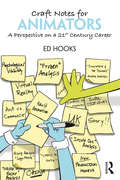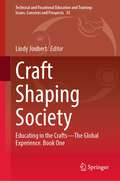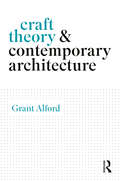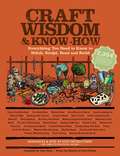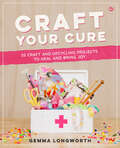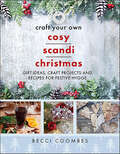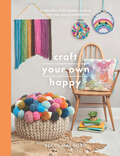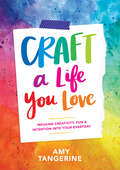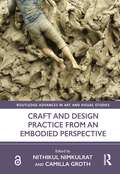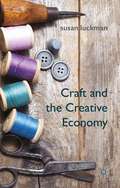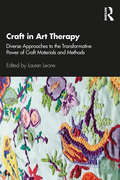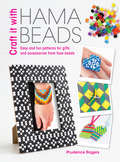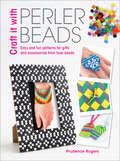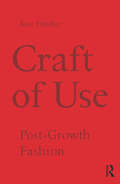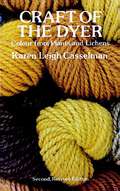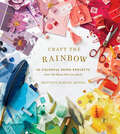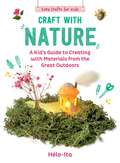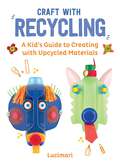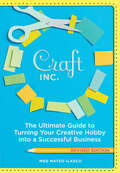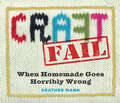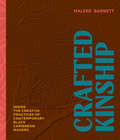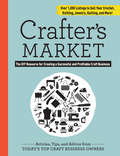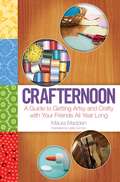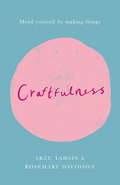- Table View
- List View
Craft Notes for Animators: A Perspective on a 21st Century Career
by Ed HooksIf Disney’s Snow White and the Seven Dwarfs represented the Animation industry’s infancy, Ed Hooks thinks that the current production line of big-budget features is its artistically awkward adolescence. While a well-funded marketing machine can conceal structural flaws, uneven performances and superfluous characters, the importance of crafted storytelling will only grow in importance as animation becomes a broader, more accessible art form. Craft Notes for Animators analyses specific films – including Frozen and Despicable Me – to explain the secrets of creating truthful stories and believable characters. It is an essential primer for the for tomorrow’s industry leaders and animation artists.
Craft Shaping Society: Educating in the Crafts—The Global Experience. Book One (Technical and Vocational Education and Training: Issues, Concerns and Prospects #35)
by Lindy JoubertThis book focusses on the role of craft as a continuing cultural practice and the revival of disappearing skills in contemporary society. It includes twenty-five essays by highly regarded artisans, academics, technologists, entrepreneurs, businesspeople, curators, and researchers from many countries representing a wide range of global craft traditions and innovations. The authors explain their professional practices and creative pathways with knowledge, experience, and passion. They offer insightful analyses of their traditions within their culture and in the marketplace, alongside the evolution of technology as it adapts to support experimentation and business strategies. They write about teaching and research informing their practice; and they explain the importance of their tools and materials in function and form of the objects they make. The essays reveal a poignant expression of their successes, disappointments, and opportunities. This book offers case studies of how artisans have harnessed the traditions of the past alongside the latest design technologies. The authors reveal how global craft is not only a vehicle for self-expression and creativity, but also for being deeply relevant to the world of work, community and environmental sustainability. The book makes the vital link between skills, knowledge, education, and employment, and fills a much-needed niche in Technical, Vocational Education and Training TVET.
Craft Theory and Contemporary Architecture
by Grant AlfordThis book offers a comprehensive exploration of craft theory in relation to contemporary architecture. Craft is an old and familiar idea, but the line between craft and art or craft and mere manufacturing, for example, is notoriously hard to describe. In architecture, a similarly blurred line between the design process, on one hand, and the physical making of buildings, on the other, lies at the center of various debates about what it means to do architecture. The growth and development of craft theory in recent years suggest new insights into these architectural debates, but situating the meaning of craft within architecture within today’s technological landscape is a complex problem. Alford responds to this challenge by collecting various narratives from craft theory and other fields and discerning among them new lenses through which to view contemporary architectural practice. Episodes from this expanded view of craft in architecture go beyond predictable accounts of Ruskin and Morris to envision: new models of practice, new ways of engaging other building professionals, and new ways for architects to understand their own labor and the nature of how and what kinds of things they themselves craft. Architecture is changing and within the ongoing story of craft explored in this book are new and surprising ways to understand, design, and construct the built environment. Written for students and scholars, this book challenges and extends the legacy of craft thinking in architecture.
Craft Wisdom & Know-How: Everything You Need to Stitch, Sculpt, Bead and Build (Wisdom & Know-How)
by Amy Rost The Editors of Lark BooksThe latest addition to the best-selling Wisdom & Know-How series is an all-in-one guide to mastering a variety of popular crafts, from knitting and quilting to ceramics and jewelry making. The fifth book in the popular Wisdom and Know-How series, CraftWisdom & Know-How covers dozens of the most popular crafts in one complete, all-encompassing resource. The book is organized by type of craft and includes Sewing, Knitting, and Other Needlework; Paper Crafts and Bookmaking; Glasswork; Jewelry Making; Pottery and Clay; Mosaics; Candle-making and Decorating; and Woodworking and Furniture Making. The sections are further broken down into chapters that cover specific crafts, each with step-by-step directions and tips for projects for all levels of skill and ability, from beginner to advanced. Hundreds of projects are included, such as Super Sock Monkeys, Crocheted Hats, Etched Glass, One-Afternoon Skirts, and Beading Vintage-Style Jewelry, to name a few. The material is hand-selected from dozens of publications from Lark Books, a leader in craft books. The information is tried, trusted, and true, and provides indispensable instruction and advice from the most accomplished crafters in the world. With hundreds of black-and-white illustrations and photographs, as well as essential resources for materials and tools, Craft Wisdom & Know-How is a must-have book for the aspiring and experienced crafter alike.
Craft Your Cure: 25 craft and upcycling projects to heal and bring joy
by Gemma LongworthA creative journey of art, craft and DIY activities to restore your mind, furniture and home, written by a TV personality with a background in art therapy.Creativity has proven benefits to our mental health, and this unique craft book shows you how to make with memories, heal through art and repair your mind.Gemma Longworth shares a collection of 25 craft and DIY projects designed to soothe our minds during difficult times. For Gemma, art has brought her comfort and connection when she has experienced loss and grief, and her personal story is woven throughout her book.With warm encouragement, Gemma demonstrates that art is about having fun and leaving perfectionism at the door. Learn how to:• use paper craft to create an origami box• make a comforting cushion• create pinch pots out of clay• draw daily doodles for healing• knit a chunky scarf• learn embellishing techniques to mend clothes• repair and upcycle furniture.With advice on how colour affects mood, how to create vision boards, how to weave memories into your projects, how to heal through meditative crafts such as drawing, and how repairing clothes and furniture can mend a broken heart, this book gives all the tools you need for your healing journey.Whether you're brand-new to crafting or a seasoned pro, turn trash into treasure with this restorative arts and crafts book.
Craft Your Own Cosy Scandi Christmas: Gift Ideas, Craft Projects and Recipes for Festive Hygge (Crafts Ser.)
by Becci CoombesChristmas is the most hyggelig of seasons, and in this book Becci shares over fifty ideas to bring a touch of Scandinavian coziness to your home this winter. The chapters cover everything from sumptuous edible gifts and homemade presents with a Nordic flavor, to traditional Danish crafts with which to decorate your space. Projects include a wild winter birch wreath, woven julestjerner star chandelier, five-minute sock gnomes and even a Christmas tree bath scrub! Try your hand at a quick finger-crochet scarf, scented white clay ornaments, or make bangles, cushions and baubles from a pre-loved sweater. Becci’s favorite recipes for the ultimate in Danish festive comfort food cover both baking and the all-important Christmas Eve feast, plus there are traditional after-dinner games for all the family to enjoy.
Craft Your Own Happy: A Collection of 25 Creative Projects to Craft Your Way to Mindfulness
by Becci Mai FordCraft Your Own Happy is a collection of mindful craft projects to make you smile! Perfect for those moments when you need a bit of self-care and relaxation time. Do you ever feel like you spend too much of your day staring at screens, feeling anxious or stressed out? If the answer is yes - then you need this book! The cute colorful projects have all been designed with the feel-good-factor in mind. Crafting can help to take you away from the worries and pressures of your daily life, and give you back those moments of slowness and focus which can help to reduce anxiety. Unlike other craft books, this is a book that you can dip into and find projects based upon how you are feeling. So you can craft to suit your mood! There are 25 beginner friendly projects to choose from including cross stitching, embroidery, paper craft and more… Why worry when you can craft happy!
Craft Your Year with Sara Davies: Crafting Queen, Dragons’ Den and Strictly Star
by Sara DaviesINSTANT SUNDAY TIMES BESTSELLER'Treat yourself with the crafting bible, Craft Your Year With Sara Davies.' Michael Ball, BBC Radio 2Step-by-step seasonal crafting guide with over 70 projects to make throughout the yearThis easy-to-follow crafting guide from the queen of crafting Sara Davies will help you and your family craft throughout the year, with projects for beginner, intermediate and advanced crafters.Packed full of ideas, tips and tricks to help you grow in confidence and creativity, as well as useful lists of tools, must-have items and a glossary explaining the key crafting terms and phrases you'll hear time and again as you craft.This practical book includes photographs and simple step-by-step instructions to help you make everything need throughout the year, from a Mother's Day card in spring to a macrame flower hanger in summer, from Halloween treat bags in autumn to a Christmas wreath in winter and everything in-between.
Craft a Life You Love: Infusing Creativity, Fun, & Intention into Your Everyday
by Amy TangerineLearn how to focus your creative energy to make things—and make things happen. In this blend of memoir and hardworking handbook, creativity and craft maven Amy Tangerine shows how to find your flow, maintain a positive mindset, and cultivate a rich and fulfilling life by focusing on what truly matters and implementing small yet powerful changes. Chapters explore how to craft the soul, craft the right mindset, craft the right environment, craft good habits, rediscover your creative mojo, and maintain momentum, with each section offering exercises for taking your creative practice to the next level. For anyone who has felt disconnected from their creativity or has had trouble saving a space for their passions, Craft a Life You Love will teach you how to make time for creativity each and every day.
Craft and Design Practice from an Embodied Perspective (Routledge Advances in Art and Visual Studies)
by Nithikul Nimkulrat Camilla GrothThis book brings together contributors from multiple disciplines, such as crafts, design, art education, cognitive philosophy, and sociology, to discuss craft and design practice from an embodied perspective.Through theoretical overviews of embodied cognition and research-based cases that involve the researchers’ making experiences, different phenomena of human‑material interaction are presented, analysed, and discussed. The practical cases exemplify ways in which embodied notions show up in action. Contributors examine topics such as the embodied basis of craft activities and material manipulation, experiential knowledge and skill learning, reflection in and on action, and material dialogues. Several chapters specifically discuss the hybrid forms of analogue and digital crafting that increasingly takes place in the field of crafts and design, and the changed notions of material engagement that this entails.The book will appeal to scholars of crafts, design, art education, anthropology, and sociology.
Craft and the Creative Economy
by Susan LuckmanCraft and the Creative Economy examines the place of craft and making in the contemporary cultural economy, with a distinctive focus on the ways in which this creative sector is growing exponentially as a result of online shopfronts and home-based micro-enterprise, 'mumpreneurialism' and downshifting, and renewed demand for the handmade.
Craft in Art Therapy: Diverse Approaches to the Transformative Power of Craft Materials and Methods
by Lauren LeoneCraft in Art Therapy is the first book dedicated to illustrating the incorporation of craft materials and methods into art therapy theory and practice. Contributing authors provide examples of how they have used a range of crafts including pottery, glass work, textiles (sewing, knitting, crochet, embroidery, and quilting), paper (artist books, altered books, book binding, origami, and zines), leatherwork, and Indian crafts like mendhi and kolam/rangoli in their own art and self-care, and in individual, group, and community art therapy practice. The book explores the therapeutic benefits of a range of craft materials and media, as well as craft’s potential to build community, to support individuals in caring for themselves and each other, and to play a valuable role in art therapy practice. Craft in Art Therapy demonstrates that when practiced in a culturally sensitive and socially conscious manner, craft practices are more than therapeutic—they also hold transformational potential.
Craft it With Hama Beads
by Prudence RogersGet fired up by fuse beads with this stunning collection of simple makes!A new wave of crafters are turning Hama Beads on their head and showing that far from being just novelties for kids, these colourful plastic beads that fuse together when ironed can be used to make stunning sophisticated gifts and accessories.In this fun collection of genuinely easy makes, you will find fuse bead patterns, designs and ideas for a wide range of items - from jewellery such as necklaces, earrings, bracelets and rings, to home décor items such as coasters, a photo frame, a garland, a clock and even a lampshade that will have you seeing Hama Beads in a whole new light!Each project has a full-colour chart plus easy-to-follow instructions to guide you through the process from start to finish.
Craft it With Perler Beads
by Prudence RogersGet fired up by fuse beads with this stunning collection of simple makes!A new wave of crafters are turning Perler Beads on their head and showing that far from being just novelties for kids, these colourful plastic beads that fuse together when ironed can be used to make stunning sophisticated gifts and accessories.In this fun collection of genuinely easy makes, you will find fuse bead patterns, designs and ideas for a wide range of items - from jewellery such as necklaces, earrings, bracelets and rings, to home décor items such as coasters, a photo frame, a garland, a clock and even a lampshade that will have you seeing Perler Beads in a whole new light!Each project has a full-colour chart plus easy-to-follow instructions to guide you through the process from start to finish.
Craft of Use: Post-Growth Fashion
by Kate FletcherThis book explores the ‘craft of use’, the cultivated, ordinary and ingenious ideas and practices that promote satisfying and resourceful use of garments, presenting them as an alternative, dynamic, experiential frame with which to articulate and foster sustainability in the fashion sector. Here Kate Fletcher provides a broad imagining of sustainability in fashion that gives attention to tending and wearing garments, and favours their use as much as their creation. She offers a diversified view of fashion beyond the market and the market’s purpose and reveals fashion provision and expression in a world not dependent on continuous consumption. Framing design and use as a single whole, the book uncovers a more contingent and time-dependent role for design in sustainability, recognising that garments, while sold as a product, are lived as a process. Drawing from stories and portrait photography that document the ways in which members of the public from across three continents use their clothes, and the work of seven international design teams seeking to amplify these use practices, Craft of Use presents a changed social narrative for fashion, borne out of ideas of satisfaction and interdependence, of action, knowledge and human agency, that glimpses fashion post-growth.
Craft of the Dyer: Colour from Plants and Lichens
by Karen Leigh CasselmanCraftspeople interested in traditional methods will welcome this complete guide to making and using dyes from plants. Although its emphasis is on plants of Northeastern North America, many of the plants listed are found throughout the world.Helpful introductory chapters on equipment, mordants, dyeing procedures and other essentials, are followed by individual plants: its suitability for dyeing, useful parts, how to process them, colors, dye fastness, plant identification, where to find it, and more. Also include four valuable indexes -- plants by common name, botanical name, by colors produced, and a general index. A list of suppliers, metric conversion tables and other information rounds out this thorough guide to safe, ecologically sound dyeing methods.
Craft the Rainbow: 40 Colorful Paper Projects from The House That Lars Built
by Brittany Watson JepsenThe popular craft designer and lifestyle blogger shares a rainbow of new project ideas—all using the creative power of paper.What began as a project collection and viral Instagram hashtag (#CrafttheRainbow) has become an inspiring book featuring all-new paper project ideas. Learn how to make playful party decorations, luscious flowers, amazing cards, and sophisticated wreaths, garlands, centerpieces, and more than you can imagine. Brittany Watson Jepsen is known for the unusually imaginative and amazingly beautiful designs she creates for her website and host of clients (including Anthropologie). In Craft the Rainbow, Jepsen walks readers through the easy basics of transforming simple paper—including tissue, crepe, cardstock, leaves of books, and vintage and recycled paper—into vibrant, fanciful, handmade projects suitable for every occasion.
Craft with Nature: A Kid's Guide to Creating with Materials from the Great Outdoors (Easy Crafts for Kids #1)
by Héloïse Charier-MaurelEnter the world of an artist with a natural spirit in this collection of crafts inspired by your surroundings! In this guided collection, young crafters and artists will find step-by-step instructions and full-color photographs that will aid them in creating decorations and playful projects using elements of the natural world. Author and artist Hélo-Ita opens with encouraging words that will inspire crafters to pay closer attention to the environment and all it has to offer when outdoors, whether they&’re on a serene hiking path in a forest, dipping into the waves at the beach, or simply playing in their own background or walking to school. You never know which materials you may find! The projects featured throughout this fully-illustrated book can be created as displayed on the page and may inspire future crafts. Types of creations include greeting cards, sculptures, light displays, kawaii rock pets, mobiles, ships in bottles, and tea light villages—all requiring the most basic supplies (tape or glue, scissors, paints or pens, thread) and whatever natural materials you source!
Craft with Recycling: A Kid's Guide to Creating with Upcycled Materials (Easy Crafts for Kids #2)
by Stéphanie BoulayIn this guided collection, young crafters and artists will find step-by-step instructions and full-color photographs that will aid them in creating decorations and playful projects using elements they have designated for reuse or upcycling. Author and artist Stéphanie Boulay, known as Lucimari, opens with encouraging words that will inspire crafters to pay closer attention to their surroundings for materials that may otherwise be thrown away, such as cans, bottles, scraps of paper or felt, unused and mismatched yarn. You never know which materials may be given a second life! The projects featured throughout this fully illustrated book can be created as displayed on the page and may inspire future crafts. Types of creations include masks, figurines or toys, mobiles, desk organizers, and more.
Craft, Inc.: The Ultimate Guide to Turning Your Creative Hobby into a Successful Business
by Meg Mateo IlascoThis revised and expanded edition of the definitive crafter’s business book covers everything from product development to social media marketing.Crafters looking to turn their hobby into a profession can rely on the tried and true advice in Craft, Inc. An author, entrepreneur, and multidisciplinary creative, Meg Mateo Ilasco offers guidance on everything from developing products and sourcing materials to writing a business plan and paying taxes. With all-new sections on opening an online shop, using social media strategically, and more—along with updated interviews from such craft luminaries as Jonathan Adler and Jill Bliss—this comprehensive primer features the most current information on starting and running a successful creative business.
CraftFail: When Homemade Goes Terribly Wrong
by Heather MannPoor Bridgit, who overestimated the size of her head—her homemade frilly lace shower cap came straight down to her chin. And who can blame Lindsey for thinking “glitter shoes” sounded like a cool, easy project instead of what it turned out to be: a puddle of sparkling glop. And really, whoever posted that incredible Spaghetti-Stuffed Garlic Bread on Pinterest should be sued. When Mindy pulled hers from the oven, it looked like a “hot mess of intestines streaming out of doughy flesh.” Mmmm, thank you, Pinterest! Written by Heather Mann, publisher of CraftFail.com, her hilarious blog with millions of page views and hundreds of thousands of followers, CraftFail celebrates the creative process, but from the other side. This is the stuff that gets the “A for Effort” and LOL for outcome. But once the laughter dies down, it also inspires a warm feel-good respect for crafters who aren’t afraid to fail. After all, even if there’s not a mortal alive except Martha who can make a Waxed Heart worthy of hanging in your window to catch the sun, why shouldn’t many try? When it goes wrong, why shouldn’t the rest of us enjoy this Epic Fail? And then look at all the full-color photos that document it. Home decor fails, fashion fails, holiday fails, food fails, kid crafting fails— as one anonymous crafter said: “It wasn’t supposed to end this way.” Luckily for us, it did.
Crafted Kinship: Inside the Creative Practices of Contemporary Black Caribbean Makers
by Malene BarnettA visual journey of Caribbean art profiling more than 60 contemporary Caribbean artists, curated by award winning multidisciplinary artist and textile surface designer, Malene Barnett. Through powerful interviews with more than 60 artists and designers of Caribbean heritage, accompanied by gorgeous photographs, Crafted Kinship takes readers on a unique journey through the world of Black Caribbean creativity. Each maker crafts a kinship with the land, the people, the culture of their country of origin. Their art explores and reflects deeply on themes like African origins, ancestors, Black womanhood/Black manhood, identity, joy, memory, and the complicated and painful history of migration and diaspora. An art that is more often than not multidisciplinary, created by makers who eschew traditional labels by reshaping the boundaries around art and design. Curated by Malene Barnett, an award-winning multidisciplinary artist and textile surface designer of Jamaican and Vincentian descent, Crafted Kinship is the first book in which Caribbean makers share the intimate stories of their art-making process and how their countries of origin influence and inform how and what they create. Included are makers working across all mediums. Meet Anina Major, a Bahamian visual artist whose work attempts to reclaim the significance of straw basketry through her ceramics; Basil Watson, a Jamaican figurative artist and sculptor famous for his stunning bronze figures that are exhibited outdoors all over the world; Renee Cox, a Jamaican photographer whose work celebrates Black womanhood; La Vaughn Belle, a multidisciplinary artist from St. Croix who draws from archival sources to interrogate colonial legacies; Sonya Clark, a textile artist and educator of Jamaican, Trinidadian, and Bajan heritage who works with hair and other meaningful materials to explore issues of power, race, and gender; and Nyugen E. Smith, an interdisciplinary artist of Trinidadian and Haitian ancestry whose fluid stream of consciousness is expressed through objects, performance, music, and moving image.
Crafter's Market: The DIY Resource for Creating a Successful and Profitable Craft Business (Market)
by Abigail Patner GlassenbergTurn Your Crafting Into a Career! All over the world, creatives are turning their hobby into their livelihoods--and Crafter's Market offers the competitive edge you need to make your craft your career. This comprehensive guide will introduce you to a new world of possibilities for taking your craft to the next level. To help you on your journey, this edition is updated with fresh resources, such as:Over 250 new listings for complete, up-to-date contacts and submission guidelines for more than 1,500 craft market resources, including craft shows, publishers, marketplaces, and more!Informative, inspirational articles on building your brand, customer communication, teaching classes, getting press coverage, photographing your goods, and more, from successful craft business owners.Actions you can take today to grow your business now, no matter your creative medium--quilting, sewing, knitting, crochet, papercraft, or jewelry making!Whether you're looking to expand your online presence or you're just beginning to think about how to turn your weekend hobby into a side business, Crafter's Market is the complete resource for creative professionals.
Crafternoon
by Maura MaddenHello, Crafternooners! Maura Madden invites you to enjoy a fun-filled afternoon of crafting.... Named after a monthly event that comedian and crafting superstar Maura Madden began hosting in 2002 as a way to get her friends together, meet new people, and have a good time making some cool stuff, Crafternoon is both an entertaining how-to guide and an irreverent social manifesto. Organized by month and theme, Crafternoon explains how to create and host a fun-filled casual gathering (including recipes for snacks and decorating tips) that celebrates the art of crafting. Knot nautical-themed crafts to wear, quilt new additions to your home decor, make the perfect gift for any holiday, or feel free to BYOP (bring your own project). All crafters are always welcome and encouraged to bring guests, and if your knitting or clay-shaping skills are a bit rusty, that's fine, too -- there are instructions aplenty! A must-have for anyone who wants to get their craft on, this quirky guide offers a twelve-month blueprint for a year of connecting with friends old and new, and enjoying a possibly messy, but always fulfilling afternoon.
Craftfulness
by Rosemary Davidson Arzu Tahsin'Making things can mend your mind' - Telegraph'Chicken soup for the crafter's soul' - Publisher's Weekly_______What is that unique feeling that goes hand-in-hand with making something from scratch? Do you ever wonder where the time goes when you're lost in drawing or working with clay? Are you happiest when you're sewing or knitting?Craft enthusiasts are no doubt already aware of the joys of making and the frustration when you must put aside your project and go back to your day job or to less enticing tasks around the house. But there is more to crafting than the simple enjoyment of a creative hobby.Drawing on the first-hand accounts from everyday crafters, Craftfulness considers the vital well-being effects to be gained from the simple expression of your creativity, and investigates the soul-cleansing and stress-relieving benefits of making things by hand. An all-you-need-to-know friendly guide to inspire you to give making a go, Craftfulness:- explores the science of creativity and the authors' down-to-earth craft ethos, as well as why everyone should develop a craft habit; - suggests ways to make time in a hectic life for everyday creative work- considers how we can try to overcome self-criticism and lack of confidence- features simple but immensely satisfying craft projects to still the mind and soothe the soul, complete with beautifully illustrated step-by-step instructionsTo read Craftfulness is the first step on the path to leading a happier, healthier, more satisfying and fulfilling life.
